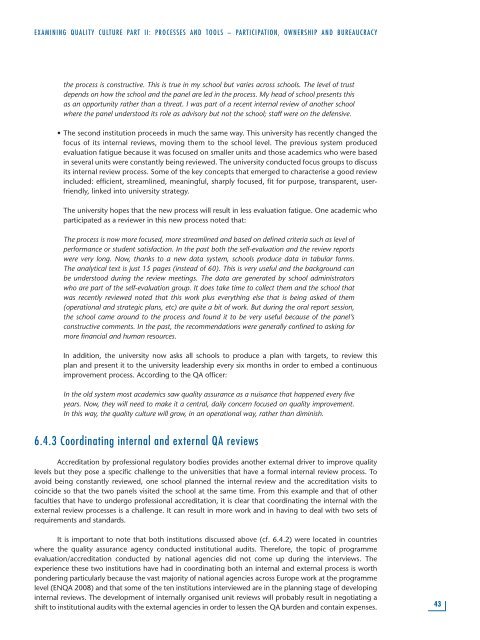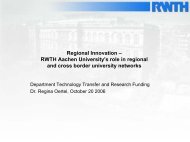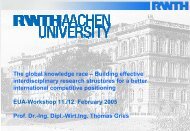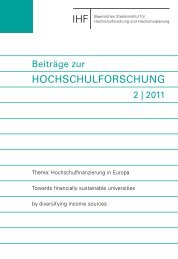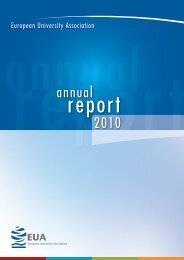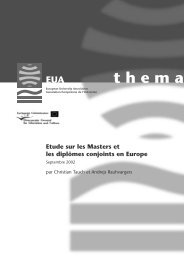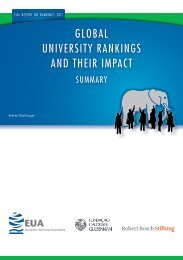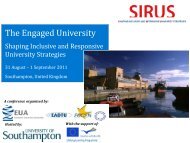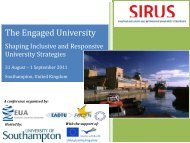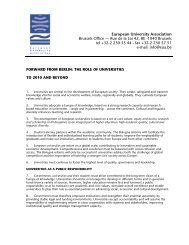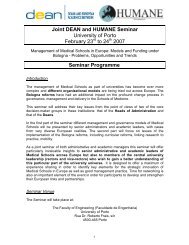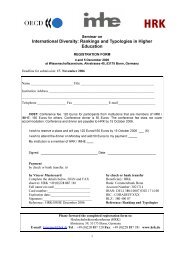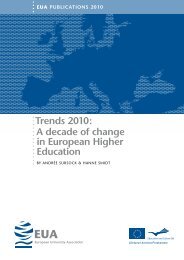Examining Quality Culture Part II: - European University Association
Examining Quality Culture Part II: - European University Association
Examining Quality Culture Part II: - European University Association
You also want an ePaper? Increase the reach of your titles
YUMPU automatically turns print PDFs into web optimized ePapers that Google loves.
ExAmININg QUALITy CULTUrE PArT <strong>II</strong>: PrOCESSES ANd TOOLS – PArTICIPATION, OwNErShIP ANd BUrEAUCrACy<br />
the process is constructive. This is true in my school but varies across schools. The level of trust<br />
depends on how the school and the panel are led in the process. My head of school presents this<br />
as an opportunity rather than a threat. I was part of a recent internal review of another school<br />
where the panel understood its role as advisory but not the school; staff were on the defensive.<br />
• The second institution proceeds in much the same way. This university has recently changed the<br />
focus of its internal reviews, moving them to the school level. The previous system produced<br />
evaluation fatigue because it was focused on smaller units and those academics who were based<br />
in several units were constantly being reviewed. The university conducted focus groups to discuss<br />
its internal review process. Some of the key concepts that emerged to characterise a good review<br />
included: efficient, streamlined, meaningful, sharply focused, fit for purpose, transparent, userfriendly,<br />
linked into university strategy.<br />
The university hopes that the new process will result in less evaluation fatigue. One academic who<br />
participated as a reviewer in this new process noted that:<br />
The process is now more focused, more streamlined and based on defined criteria such as level of<br />
performance or student satisfaction. In the past both the self-evaluation and the review reports<br />
were very long. Now, thanks to a new data system, schools produce data in tabular forms.<br />
The analytical text is just 15 pages (instead of 60). This is very useful and the background can<br />
be understood during the review meetings. The data are generated by school administrators<br />
who are part of the self-evaluation group. It does take time to collect them and the school that<br />
was recently reviewed noted that this work plus everything else that is being asked of them<br />
(operational and strategic plans, etc) are quite a bit of work. But during the oral report session,<br />
the school came around to the process and found it to be very useful because of the panel’s<br />
constructive comments. In the past, the recommendations were generally confined to asking for<br />
more financial and human resources.<br />
In addition, the university now asks all schools to produce a plan with targets, to review this<br />
plan and present it to the university leadership every six months in order to embed a continuous<br />
improvement process. According to the QA officer:<br />
In the old system most academics saw quality assurance as a nuisance that happened every five<br />
years. Now, they will need to make it a central, daily concern focused on quality improvement.<br />
In this way, the quality culture will grow, in an operational way, rather than diminish.<br />
6.4.3 Coordinating internal and external QA reviews<br />
Accreditation by professional regulatory bodies provides another external driver to improve quality<br />
levels but they pose a specific challenge to the universities that have a formal internal review process. To<br />
avoid being constantly reviewed, one school planned the internal review and the accreditation visits to<br />
coincide so that the two panels visited the school at the same time. From this example and that of other<br />
faculties that have to undergo professional accreditation, it is clear that coordinating the internal with the<br />
external review processes is a challenge. It can result in more work and in having to deal with two sets of<br />
requirements and standards.<br />
It is important to note that both institutions discussed above (cf. 6.4.2) were located in countries<br />
where the quality assurance agency conducted institutional audits. Therefore, the topic of programme<br />
evaluation/accreditation conducted by national agencies did not come up during the interviews. The<br />
experience these two institutions have had in coordinating both an internal and external process is worth<br />
pondering particularly because the vast majority of national agencies across Europe work at the programme<br />
level (ENQA 2008) and that some of the ten institutions interviewed are in the planning stage of developing<br />
internal reviews. The development of internally organised unit reviews will probably result in negotiating a<br />
shift to institutional audits with the external agencies in order to lessen the QA burden and contain expenses.<br />
43


